CASE CLUB SELECTIONS – December, 2023
- Luis Segundo Correas ‘El Cipres’ 2021 Malbec, Mendoza Argentina, $14
- Can Blau Red Blend, Monsant Spain, $19
- Aldinger 2022 “Feldhase” Trollinger, Germany $21
- J. Laurens Cremant de Limoux, France $19
- Delobel 2021 Touraine Sauvignon Blanc “Angl Droit”, France $21.50
- Chesebro 2022 Vermentino, Monterey CA, $22
- Handley Chardonnay, Anderson Valley, CA, $27
- Bodegas LAN 2019 Rioja “D-12”, Rioja Spain, $26
- Mas de Gourgonnier Rouge, Les Baux France (Certified Organic)$22
- Vara, American Silverhead Brut, California and Priorat, $21
- Hoss Cabernet, CA $32
- Obsidian Wine Co Poseiden Vyrd Pinot Noir, $41
1. Luis Segundo Correas ‘El Cipres’ 2021 Malbec, Mendoza Argentina, $14
The Wine
El Cipres represents what Argentine Malbec tasted like fifteen years ago before everyone started over-extracting and over-oaking it. From 80-year-old estate vines!! If the wine world was rational, this would be stacked and poured everywhere. Of course, it is far from rational, so we’re pleased to remain a missionary, singing the praises of this undiscovered gem.
An dense, ruby wine with aromas of dark fruits, sweet spices and black pepper. Hints of cedar, leather and graphite. The tannins are notable but pleasant, and are already integrating rapidly in the six months between my tastings. Pair it with grilled meats (Argentina is known for its beef, after all!), BBQ, lamb, hard cheeses and dark chocolate desserts.
At this price, how is it even be possible to deliver so much wine?
To say it punches above its weight class is an understatement.
Stupid good value.
The Winery
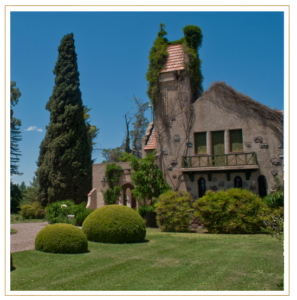 The Correas family began growing grapes in Mendoza in 1860 when Don Segundo Correas built the family’s first winery. By the 1930’s, the winery was led by Julian Correas, who gaine fame for producing some of Mendoza’s finest Cabernet Sauvignon. Luis Segundo Correas, the third generation of his family to craft Argentine wine, continues to build on this history at the humble winery space he built in the mid-1970’s.
The Correas family began growing grapes in Mendoza in 1860 when Don Segundo Correas built the family’s first winery. By the 1930’s, the winery was led by Julian Correas, who gaine fame for producing some of Mendoza’s finest Cabernet Sauvignon. Luis Segundo Correas, the third generation of his family to craft Argentine wine, continues to build on this history at the humble winery space he built in the mid-1970’s.
The family’s ‘El Cipres’ line of wines is named for the Cypress tree in front of the original family home (right), which now serves as their summer home. They are accustomed to moving between locations – their 350+ acres of vines are spread across 8 states in Argentina.
With that many grapes at their disposal, it’s no wonder all their wines come from their estate fruit.
Their “El Cipres” Malbec provides so much wine, it’s a no-brainer for your every-day red, and should even be allowed to elbow its way into your consideration set for special occasion and gift wines!
2. Cellars Can Blau 2019 Red Blend, Monsant DO, Spain (Organic) $19
The Wine
Perhaps you’re already well acquainted with “GSM” – the nickname for the wines of Southern France that are a blend of Grenache, Syrah and Mourvedre? Well it’s time to expand that friends group with a “GCS” wine, starting with this red blend of Garnacha (AKA Grenache), Cariñena (AKA Carignan) and Syrah. OK, maybe the acronym is missing a bit of cachet, but trust me, the wine isn’t!
The varietal blend is only part of the story here, as the soils share equal billing. The Garnacha vines are planted on metamorphic rock soils known as llicorella – a schist ‘soil’ that is difficult for American’s to say. My best phonetic interpretation is LICK or ray yah, but there’s a y in front of the LICK, which makes me stumble everytime. I forgive you if you prefer to just live it out and start with the LICK. Moving on – the Cariñena vines grow in clay soils (which are much easier to pronounce!), and the Syrah grows in limestone soils. Each soil type lends great complexity to a wine fermented in stainless steel tanks before being aged in new french oak barrels for 12 months – most uncommon in a wine under $25!
Tasting Notes – The wine begins with an inviting cherry color with purple highlights. Its aromatics include ripe fruit and spice notes, both high-toned red fruit/floral notes with dark fruit as well. This is a worthy example of wines from the D.O. Montsant. Fruity, powerful, meaty (beef jerky?) and concentrated. The wine provides comfort on a cold winter night, or a summer night at the beach!
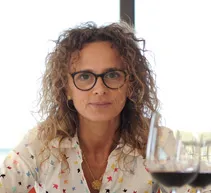
Winemaker Nuria Lopez Sarroca
Pair this wine with game meat and creamy rice dishes, paella, grilled or roasted poultry, pork, lamb or beef, braised vegetables, and hard cheeses or blue cheeses.
The Winery
Cellars Can Blau are part of the Gil Family wineries. One of Spain’s largest wine groups, my opinion of them and their winemaking practices has only grown with each of their wines I taste. They are located in the Montsant DO, which shares the same mountain as Priorat, surrounding that more prestigious region like a donut tossed onto the cone, with Priorat at the top.
Over the past decade, Montsant has really begun to show its stuff on the world stage, leveraging its soil diversity and homing in on the best grape varieties to grow in their unique terroirs. In general, these tend to be big, bold wines with a loud voice and something interesting to say.
Winemaker Nuria Lopez Sarroca (right) has been toiling at her craft since 1997, and prides herself on wines that reveal the characteristics of place, while leveraging contemporary equipment and techniques to bring that charcter to the fore.
3. Aldinger 2022 “Feldhase” Trollinger, Germany, $21
The Wine
From a 35 year-old plot in the Lämmler (a Grosse Lage), this is a mid-weight but strikingly saline and insistent wine that demonstrates the impact that Trollinger can make when deliberately constrained by low yields and the vinification is as serious as that accorded to Pinot Noir. For example, the vines were between 25 and 50 years old, the grapes were partially whole-cluster fermented, pump-over occured daily, and the fermented wine aged in used barriques for a full 12 months prior to release. Much like a pinot noir costing twice as much.
Tasting notes: Light and pinot-esque in style. Comparable to the Beaujolais-crus of Marcel Lapiere. Clear and elegant with a refreshing character.
A precious 250 cases produced. Very little imported.
The Winery
This wine finds its home in the German region of Württemberg. As a wine region, itis undeniably obscure outside of Germany. But it enjoys tremendous renown at home for its renditions of autochthonous grapes such as Trollinger, also known as “Schiava” in Northern Italy.
Württemberg is better known within automotive circles, as Germany’s automotive capital, Stuttgart, is located here. And this well-paid employee base seems to suck up the lion’s share of the region’s wines. So there is little motivation for the best producers to seek export markets.
This is the background against which we had the unbelievable good fortune to add this celebrated producer to our shelves. Aldinger is the first and only producer in Württemberg to be awarded “5 grapes” and 100-points by the celebrated Gault Millau guide. The Aldinger family has been in Fellbach since 1492, both as coopers and wine-growers.
The family set the foundation for what is today the region’s oldest winegrowing estate. Fast forward almost 500 years to 1955, when Gerhard Aldinger married Anneliese Aldinger (neé Pflüger) and decided to convert his father-in-law’s existing cooperage into a full-scale winery.
The 1973 they acquired the Untertürkheimer Gips vineyard, and in their capable hands the wines from this vineyard soon lent a new meaning to the word GIPS: distinctive, mineral-rich wines unlike any produced here before.
In 1992 – Building on 500 years of wine growing tradition, Gert Joachim Aldinger takes the helm. Dubbed the ‘King of the Kappelberg,’ Gert Joachim Aldinger’s decision to radically reduce yields flew in the face of conventional wisdom, breaking new ground in the region. Within 15 years, the estate was considered among Württemberg’s finest.
Today the winery is ably helmed by brothers Hansjörg and Matthias Aldinger, who have been propelled into the stratosphere of quality and acclaim. Their urban winery lies within spitting distance of the Mercedes Benz headquarters and Museum (whose exceptional restaurant, open to the public, naturally offers their wines). In short, what we have here is as good a wine producer as Germany offers.
This seamless transition from one generation to the next is a tremendous point of pride for both the family and the estate.
4. J. Laurens NV Cremant de Limoux, France $19
The Wine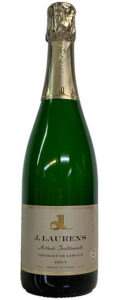
If you’ve been reading my posts since I began them in April, you’ve likely picked up that I’m a fan of good bubbles. And while that usually means the sparkling wine is from Champagne, I also get happy whenever a cork flies out of a bottle of Franciacorta, Cava, Trentodoc, or… Limoux?!
Wines from this region were originally called Blanquette de Limoux. This is a horse of a very different color. Blanquette uses different grapes (slightly sweeter) and a single fermentation in the bottle (like today’s Pet Nat wines) resulting in greater bottle variation and lower pressure, which leads to a shorter life span for the mousse.
Well, this ain’t that! Here’s what you can expect from this bottle of J. Laurens Cremant de Limoux: Aromas of Granny Smith apples carry over to a palate where tart red apples (Pink Lady?) join the parade where whisps of lemon curd bring up the rear. Bready yeast notes lead to a pleasant double-take – am I drinking Champagne here? Def not, but you’d be excused for thinking so, and for thinking the bottle cost 2X its modest tariff!
This is a wine to keep on hand. Stock up on a half case so you always have something to serve impromptu visitors!
The Winery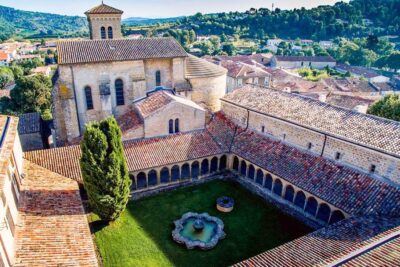
First, let’s clarify that a Cremant is simply a French sparkling wine that is NOT from the Champagne region (Cremant de Jura, de Limoux, de Bourgogne…).
It uses different grapes than Champagne, but that’s about it – the blending of still wines, the secondary fermentation in the bottle, the aging (slightly less is required, 12 months for non vintage vs Champagne’s 15)… it’s all in here.
But Limoux has some cool history that even Champagne can’t claim – it just may be the origin of sparkling wine production. Limoux is home to an Benedictine abbey called Saint-Hillaire, which historians credit with the discovery of sparkling wine in 1531, about 150 years before it was commonly produced in Champagne!
Whaaaa??? Why? How? It was Limoux’ proximity to the cork forests of Catalunya and the stronger glass from England that made their sparkling wine production possible. Cork, it turns out, is adept at maintaining the bottle pressure required to keep a sparkling wine’s effervescence.
For most of Limoux’ history, their sparkling wines were made from the obscure red grape called Mauzac and known as “Blanquette de Limoux”. But in 1990 the AOC Cremant de Limoux was created, and these wines lead with Chardonnay and Chenin Blanc, relegating Mauzac and sometimes even Pinot Noir to supporting roles.
5. Delobel 2021 Touraine Sauvignon Blanc “Angl Droit”, France (Organic/biodynamic) $21.50
The Wine
Angl Droit. Right Angle. What does this have to do with wine? I’ve no idea, and the winery’s website is all in French, so if it’s explained there, my translator didn’t pick up on it! I suspect it depicts the intent of this husband-wife team, tiny producers opting for an approach to winemaking that is at odds – ar a right angle – to conventional production methods. Deploying organic and biodynamic practices in their estate vineyard, Benjamin et Sandrine Delobel are producing exceptional wines of great value!
Sauvignon blanc is a grape that reflects terroir like few others. Grown in a cool region like New Zealand, it produces crisp white wines dominated by citrus (grapefruit, kiwi) and grassiness (hay, basil, fresh-mown lawn).
Plop that same vine in (much!) warmer Napa Valley and the wine becomes entirely different – a familial resemblence can be noted by the careful taster, but the differences are vast. These wines are more likely to be oaked, a winemaking decision made to emphasize the naturally rounder and richer with more subtle varietal character and riper fruit notes (melon, peach, lychee…)
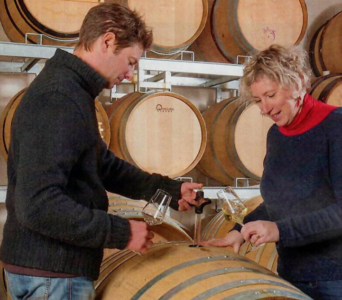
Benjamin & Sandrine
Right in the middle of these two extremes are the Sauvignon Blancs of Touraine and the greater Loire valley, often seen as the highest expression of the variety. Look for mouth-watering acidity complimented by a stony minerality that begs to be paired with lighter dishes such as seafood, salads, and (especially!) goat cheese.
The Winery
Touraine is one of the better-known regions of the Loire Valley, which runs 600 miles from its origin in the hills west of sourthern Burgundy, out to the Atlantic ocean on the western side of France. But there are many sub-regions in Touraine (Vouvray, Montlouis-sur-Loire, Chinon…) each with their own reputation for unique terroirs and wine styles.
The dream of a young couple, Benjamin and Sandrine Delobel, this is a relatively young winery even by new world standards, and amidst the towering edifices that are Loire’s old guard, we are thrilled to encourage the Delobels with our selection forthis month’s wine club and their introduction to you!
6. Chesebro 2022 Vermentino, Cedar Lane Vyrd, Monterey CA, $22
The Wine
The Winery
7. Handley Chardonnay, Anderson Valley, CA, (Organic) $27
The Wine
Geeky Notes: This wine is made from Handley’s organically-farmed (CCOF Certified) Handley Estate Vineyard, a field blend of two clones of Chardonnay – the Robert Young clone and the Burgundian clone ’76’.
Tasting Notes: Aromas of citrus blossom, cooked apples, warm toast, caramel, and nutmeg. On the palate look for hints of crisp lime, ripe pineapple, tart Gala apples and toasted almonds. The wine makes a soft entry, grows into a round and full mid palate, and finishes crisply, with lingering fruit notes.
Barrel fermented with regular lees stirring through completion of fermentation, then aged for 8 months in 100% French oak barrels (20% new). About one third of this was put through malolactic fermentation to add complexity and that round mid-palate mouthfeel, and to provide a counterpoint to the wine’s natural crispness.
1,404 cases produced.
Alcohol: 13.2% ABV
Acidity: TA 5.0 g/L, pH 3.55
The Winery
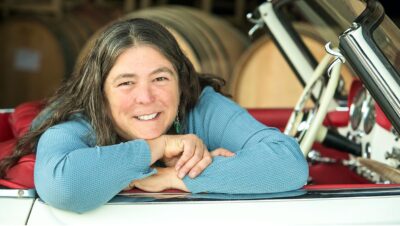
Milla Handley, 1951 – 2020
Founding winemaker Milla Handley passed away suddenly and unexpectedly three years ago due to COVID. A woman who overcame so many obstacles in her long career, her unexpected passing came as a huge shock to the Anderson Valley, a small and tightly-knit community, where Milla had been the “Pioneer Queen” for almost 40 of her 68 years.
8. Bodegas LAN 2019 Rioja “D-12”, Spain, (Sustainable) $26
The Wine
Produced with selected vi nes from small parcels in the Rioja Alta and Rioja Alavesa, LAN D-12 revives the Riojan tradition of choosing their best tank to keep to drink themselves! D-12 refers to the tank that was selected.
nes from small parcels in the Rioja Alta and Rioja Alavesa, LAN D-12 revives the Riojan tradition of choosing their best tank to keep to drink themselves! D-12 refers to the tank that was selected.
GRAPE VARIETIES: 100% Tempranillo
TASTING NOTES: The wine begins with an inviting, bright cherry color and segues into aromas of licorice, ripe red fruits with dairy nuances (cream more than cheese), toffee, vanilla, sweet pie spices and cocoa. On the palate it shows harmony between the fruit and the toasted notes that evolves over and over again on the palate. Round tannins lead into a good long-lasting finish of red fruit and liquorice.
VINEYARDS: This year the wine came from three plots: El Cementerio (Viñaspre), Los Valles (El Cortijo), and La Fonsagrada, (San Vicente de la Sonsierra), with vine age ranging from 30 to 45 years.
WINEMAKING: Fermented in stainless steel tanks at a controlled temperature no higher than 77 degrees (F) – cool enough to preserve the wine’s beautiful aromatics while still enabling full color extraction from the skins. Micro-oxygenation was allowed while the wine was still macerating on the gors lees. Finaly, malolactic fermentation balanced the tannins so they now display a silky mouthfeel in the bottled wine.
AGING: Twelve months in new American and French oak barrels followed by 1 year of rounding in the bottle prior to release. The American oak was sourced in the Appalachians and the French oak in the forests of Chateauroux and Loches. Continue reading for more about Bodegas LAN’s unique hybrid barrel program!
The Winery
Modern wines from Rioja have become known for their use of American oak barrels. Until recently, it was a reliable marker for these wines. But, known for lending distinctive notes of coconut and dill to wines, American oak barrels have their fans as well as their detractors.
LAN takes a different path. In order to create wines that faithfully reflect the winery’s old-vine vineyards, they’ve created a very cool and unique barrel regimen.
First, take a look at their barrel room (right). It involves an atomated system of stacking and racking that makes efficient use of the temperature-controlled space.
But Bodegas LAN are also known for integrating oak from various forests into their barrels, using oak from America, France, Russia, Hungary and the Pyranees. Some of their barrels are even hybrids, using staves from American oak and heads from French oak, for example. They then select the barrels that best compliment each particular wine, using the wood’s aroma/flavor profile as their guide:
- French oak. From different forests in central France (Allier, Troncáis, Jupille, Blois…), these barrels provide great aromatic complexity, with delicate notes of spice (clove, cinnamon), touches of menthol, smoke and cocoa. It adds a considerable amount of tannins, giving great structure on the palate.
- American oak. Sourced in Ohio and Missouri from the Appalachian forests, it adds intense aromas of vanilla, coconut and aromatic plants. See prior note on coconut/dill.
- Russian oak. From the Caucasus and the Republic of Adygea. It is similar in aromas to French oak but less pungent, respecting the primary aromas of the grape.
- Hungarian oak. Aromatically similar to French oak. In the case of Tempranillo, it adds slightly more lactic (dairy) notes.
- Pyrenean oak. It is high in polyphenols, adding vanilla, caramel, almond, clove and resinous notes. It is the latest type of oak to be added to LAN’s ageing process.
9. Mas de Gourgonnier Rouge, Les Baux France (Certified Organic) $22
The Wine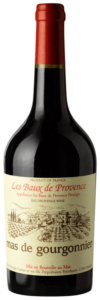
Produced by the Cartier family (no, not THAT Cartier), Luc, Eve (Luc’s daughter) and Lucienne, these wines combine the richness and intensity of top Rhone or Bordeaux with a crystal-clear and unmistakable expression of Provençal soil.
The wine is a blend of Grenache, Syrah and Cabernet Sauvignon (50% / 24% / 26%) from 20-30-year-old vines that have been organic since their origins in the 1950s. Elevation was in a combination of stainless-steel tanks and well-used French casks before being bottled (unfined / unfiltered). The fun and distinctive, squatty bottle is the same style used for the family’s first wines in the 1950s.
Tasting notes: Dark garnet in color, the wine offers aromas of blueberries, bramble fruit, wisps of smoke and spice. On the palate we found dusty black fruits (plum, blach cherry), pipe tobacco, leather, lavender and the other tantalizing herbal elements known as “garrigue”.
The Winery
Les Baux, a mountainous town in Southern France, takes its name from the region’s bauxite mines, a critical element in the production of aluminum, but also essential for various munitions critical to the wars of the last century. The area has a rather grusome history, with a mountain-top castle whose dining room looked out over the perch from which valley floor travellers who couldn’t afford the tariff were thrown into the abyss for their trespassing, and for dinner time entertainment, apparently.
Not to worry, the wines are far more gentle and civilized.
This winery is a perfect example of why I become so amused by the success of Johnny-come-lately brands shouting about their “Natural Wine” bona fides (I’m looking at you, Dry Farm, Cameron, Banks, Harden…). Like many, many, MANY small old-world producers, Gourgonnier has been following rigorous natural farming techniques for decades, not because they need to shout about it, but because that’s just who they are. The Cartier family has been growing and selling organic for almost two centuries. It’s just part of who they are. Their “Brand”, though use of such a word would almost surely result in a quizzical look from the Cartiers!
10. Vara, American Silverhead Brut, California and Priorat (organic/biodynamic/sustainable) $21
The Wine
In many ways, it feels as if this is a second chapter that took 25 years to write. It started in 1999 when, sitting at a friend’s wine bar in San Francisco, I was handed an unexpected glass of sparkling wine.
What’s this? I asked.
“Taste it and tell me”, she said.
Hmmm, nice and crisp, fine bubbles, brioche yeasts with a clean finish… I would guess it’s an over-achieving entry-level or maybe a mid-tier Champagne.”
I was wrong, as it turns out.
I’d just been introduced to an exciting but little-known domestic sparkling wine, fermented in bottle, that was from… wait for it… NEW MEXICO, of all places. It was really good and surprisingly affordable and it was called Gruet, after the French family with roots in Chamapgne (Champagne Gruet et Fils). Laurent Gruet was the family member who’d left Champagne for the hills of New Mexico and piloted the program.
But in 2014, Laurent sold Gruet to start a new venture – Vara – just two short years ago this month. It too is surprisingly good and affordable – Laurent hasn’t lost his magic touch, clearly. But he has some great help as well – the Lindquists, both Bob (Qupé) and Louisa Sawyer-Lindquist (Verdad, a producer of CA wines from Spanish grapes) are partners in Vara. Like Laurent, Bob recently sold Qupé and launched his own venture with Louisa. Together, they’ve partnered with Laurent to create the wines of Vara using grape sources the three of them have developed over their many decades.
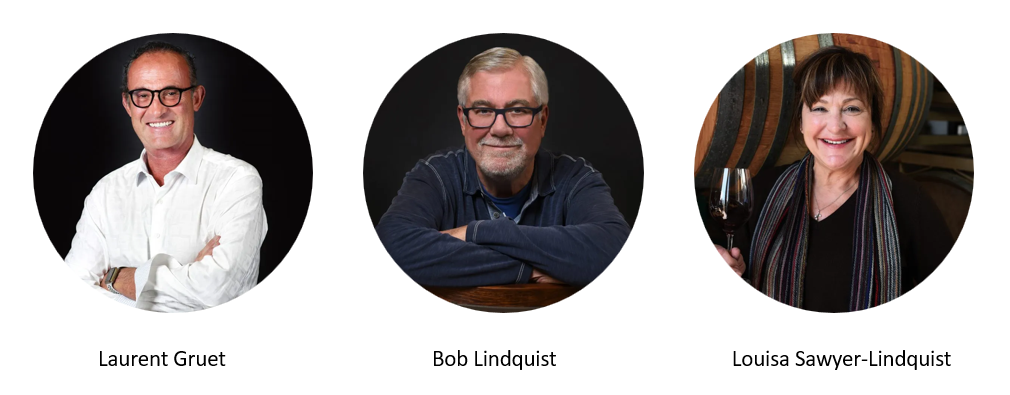
Whether the name – Vara Silverhead – refers to the silver metal cap between the cork and the cage, or Bob’s increasingly silver head of hair… who knows. Just enjoy the wine, newly released in time for the holidays. This will be a wine you’ll want to serve, both for the pleasure it delivers and the story that comes with it.
By the Numbers:
10% Chardonnay – Central Coast AVA, CA USA
15% Xarel-lo/Macabeo – Alt Penedès DO, Spain
5% Pinot Noir – Lodi-Woodbridge AVA, CA USA
5% Pinot Noir – Central Coast AVA, CA USA
TA: 8.6 / pH: 3.25 (close to grapefruit juice, for some comparison)
ABV: 12.5%
Bottled: February 2023
Winemaker: Laurent Gruet
11. Field Recordings ‘Hoss’ Cabernet, Paso Robles CA $32
The Wine
I don’t know this for a fact, but suspect this wine was named for Hoss, Ben Cartwright’s rather large son on the show Bonanza. A popular Western from the 1970s, Bonanza featured the wealthy Cartwright family, Ben was a widower whose son, Hoss (Dan Blocker), was known for his brawn.
Just like this wine – if you like big California cabs, this wine is for you. Despite its relatively modest 13.9% ABV, the wine is no shrinking violet.
Tasting Notes: Look for aromas and flavors of blueberries and black fruits, cocoa and maybe a touch of menthol, all topped by spice notes including ground black pepper and mocha. Food pairings? Andrew Jones suggests “stuff with a bone in it”, which leaves the wine open to a lot of menu options.
The Winery
Named Winery of the Year by the “Next Wave Wine Awards”, Field Recordings ticks all the boxes for natural wines – sustainable farming, native yeast fermentations, no additivies but for minimal sulfites and vegan production practices. But what I like most about their wines is that they are ‘a thoughtful reflection of a specific time, place or person’, as described by Next Wave Wines.
Winemaker/Owner Andrew Jones is at the helm of this mid-sized winery (about 40,000 cases per year). As a vineyard consultant with his fingers in many of California’s best Central Coast sites, Andrew has access to fruit from some of the best known and some of the smallest “waiting to be discovered” vineyards.
Among it all, Andrew’s developed a reputation for being able to identify diamonds in the rough, vineyards whose fruit can be better than its price and reputation would suggest. That is the foundation for Field Recordings!
12. Obsidian Wine Co Poseiden Vyrd Pinot Noir, $41
The Wine
TASTING NOTES
Fresh and approachable, the Estate Pinot Noir captures the classic character of Martini Clone Pinot Noir from the Carneros appellation – a delicate, pretty wine with a medium body, fresh acidity, and beguiling complexity. Hungarian oak adds a warm spice and earth component to the fruit’s classic aromas and flavors of rose petals and bright red cherries, with some tea leaf and herbal notes from the whole cluster stem contact.
HISTORY
Poseidon Vineyard, located at the confluence of Carneros Creek and the Napa River, was planted in 1973 by the Molnar Family to the Burgundian varietals: Pinot Noir and Chardonnay. The maritime environment of the Carneros grape-growing season delivers cool, foggy mornings followed by warm days that nurture a slow ripening.
WINEMAKING
Obsidian’s Estate Pinot Noir vineyard is primarily planted to Martini clone Pinot Noir, with one small lot of Pommard 5 clone. The fruit was harvested by hand and fermented separately. 10% of the harvest was whole-cluster fermented for added complexity. Once fermentations were complete, the wines were pressed gently and aged in the Molnar family’s Kádár Tokaj oak barrels, 70% in 300-liter barrels and 30% in a single 3,000-liter upright oval cask. The oak used to make these barrels is depicted on the label, a smaller version of an actual wood block print.
These oversized vessels add the signature spiciness of Hungarian oak to the blend at lower concentrations than standard barrels, complementing the fruit character while retaining the pure, fruit-filled expression of Pinot Noir. Aged on lees and racked only once before bottling (wihtout fining or filtration) to maintain the desired weight and complexity on the palate.
The Winery
The families behind Obsidian Ridge say they’re most at home when living on the edge. In 1973, Nicholas Molnar planted Poseidon Vineyard at the southern extreme of Napa Carneros, on what had been grazing land since the time of the missionaries.
He was among the first to farm this area which at the time was considered too cool to ripen wine grapes. For three decades, he grew chardonnay & pinot noir for the top sparkling wine houses in Napa Valley before producing still wines under their own label. When it came time for his sons to take over the family business, they felt there was an opportunity in another under-valued area within California – the red and volcanic soils of Lake County, north of Sonoma. That vineyard is home to their Cabernet Vines, while Posieden is the source for their estate Chardonna and Pinot.


